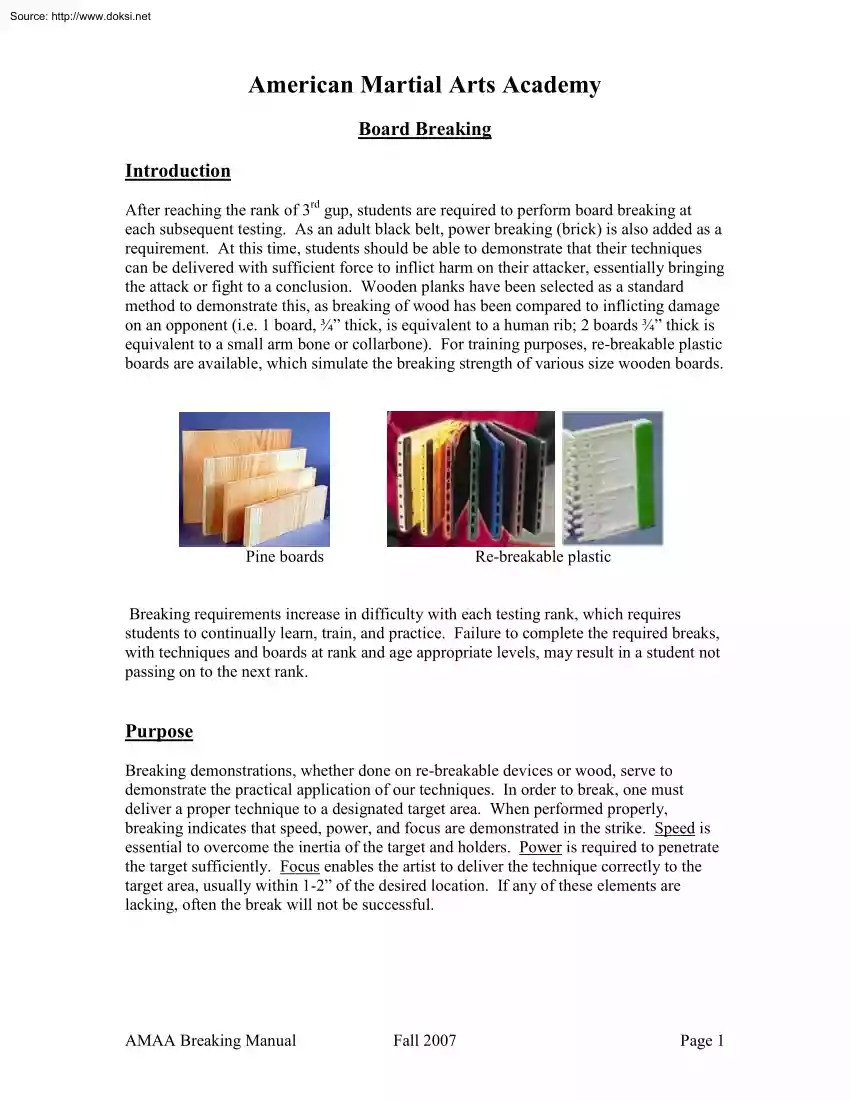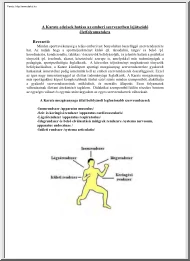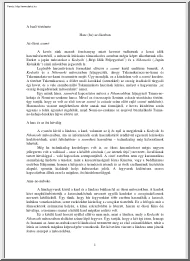Datasheet
Year, pagecount:2008, 4 page(s)
Language:English
Downloads:3
Uploaded:June 24, 2019
Size:553 KB
Institution:
-
Comments:
Attachment:-
Download in PDF:Please log in!
Comments
No comments yet. You can be the first!Most popular documents in this category
Content extract
Source: http://www.doksinet American Martial Arts Academy Board Breaking Introduction After reaching the rank of 3rd gup, students are required to perform board breaking at each subsequent testing. As an adult black belt, power breaking (brick) is also added as a requirement. At this time, students should be able to demonstrate that their techniques can be delivered with sufficient force to inflict harm on their attacker, essentially bringing the attack or fight to a conclusion. Wooden planks have been selected as a standard method to demonstrate this, as breaking of wood has been compared to inflicting damage on an opponent (i.e 1 board, ¾” thick, is equivalent to a human rib; 2 boards ¾” thick is equivalent to a small arm bone or collarbone). For training purposes, re-breakable plastic boards are available, which simulate the breaking strength of various size wooden boards. Pine boards Re-breakable plastic Breaking requirements increase in difficulty with each testing rank,
which requires students to continually learn, train, and practice. Failure to complete the required breaks, with techniques and boards at rank and age appropriate levels, may result in a student not passing on to the next rank. Purpose Breaking demonstrations, whether done on re-breakable devices or wood, serve to demonstrate the practical application of our techniques. In order to break, one must deliver a proper technique to a designated target area. When performed properly, breaking indicates that speed, power, and focus are demonstrated in the strike. Speed is essential to overcome the inertia of the target and holders. Power is required to penetrate the target sufficiently. Focus enables the artist to deliver the technique correctly to the target area, usually within 1-2” of the desired location. If any of these elements are lacking, often the break will not be successful. AMAA Breaking Manual Fall 2007 Page 1 Source: http://www.doksinet Preparation Students should NEVER
attempt to perform any technique until they have been properly trained by an instructor. This is especially crucial when applied to board breaking, which requires knowledge and training not available to all students. Attempting to break when not trained or supervised may result in permanent injury to the student or holders. After initial instruction, students should train by practicing proper techniques on padded ‘slapper’ targets, to develop the power, speed, and focus necessary to complete a break. Repeated practice in this manner will develop the skill necessary to deliver a technique consistently within a small target area. Additionally, students should practice their technique on a heavy bag or shield to reinforce the accuracy and power required. ‘Slapper’ targets Kicking shields Heavy bag Once the student has demonstrated satisfactory performance in target drills, he/she should then move on to re-breakable boards. This will simulate the effort and accuracy required to
break wood, and will allow repetitive practicing with a minimum of cost and waste. Only after satisfactory demonstration of breaking skills on re-breakable boards should a student move on to attempt breaking wood. Students are required to receive approval from an instructor at each stage of this progression, and must always break under the supervision of an instructor or parent. Mental Approach As with most athletic endeavors, board breaking requires a tremendous concentration in order to deliver a properly executed technique, with the necessary power and speed, within a small target area. When one adds in the pressure experienced during a testing event, the mental aspect of breaking becomes even more important. The first element of the mental approach is preparation. When a student is properly instructed on how to break, has practiced extensively on targets, and repeated the break with re-breakable or wood boards, he/she will be prepared to handle the additional stress of a testing
environment. The second element of the mental approach is confidence. Successfully repeating the break in a ‘safe’ practice environment will develop the knowledge that if the technique is sound, delivered effectively and on target, the board will break! This confidence can only be gained through repetition and practice. Students must know, deep down inside, that they are the master over the board! AMAA Breaking Manual Fall 2007 Page 2 Source: http://www.doksinet The final element of a successful mental approach is focus. Martial artists are trained to close their minds to outside distractions (when appropriate) and concentrate on the task at hand. Blocking out other activities and noises will allow a student to deliver a correct and powerful blow within a target area of 1-2 inches, time after time. Approved Techniques Students must select one of the following techniques when breaking wood or rebreakable boards. These techniques have been selected in order to demonstrate a
wide variety of techniques, while ensuring minimum risk of injury. Approved hand techniques Hammer fist Palm Heel Elbow Strike Elbow Back Strike Knife Hand Front Punch Reverse Punch Approved foot techniques Front Kick Round Kick Side Kick Back Kick Crescent Kick Axe Kick Hook Kick (all can be performed standing, jumping, or spinning) Board Holding One of the most over-looked aspects of board breaking is the technique of board holders. If the holders are not sufficiently stable, the energy of the student will be absorbed by the holders, and the break will not be successful. Holders should be placed in a strong, deep front stance; fully extend the arms with elbows locked; hold the board along the outside edges (along the grain); and turn their heads to the side before the break is attempted. Whenever possible, boards should be supported on all four corners to ensure stability. Grain should be aligned so the technique is fully delivered along the grain line, and if ‘cupped’ grain is
present, it should be facing the holders. AMAA Breaking Manual Fall 2007 Page 3 Source: http://www.doksinet Board selection All boards should be cut from commercially available ‘1x12’ planks, which are available at lumber yards and home improvement stores. The true measurements of these planks are ¾” thick by 11-3/8” wide, and come in varying lengths. Age Under 7 years 7 – 8 years 9-10 years 11-13 years 14-18 years Adult Adult male BB Board length (along grain) 3 inches 5 inches 7 inches 9 inches 11 inches 11 inches 11 inches (2 boards) Re-breakable board (equivalent boards) White (3”) Yellow (5”) Orange (7”) Green (9”) Blue (1.25) Brown (1.75) Black (2.25) 12 inches (11-3/8” as purchased) Board Length Testing Requirements Current Rank 3rd Gup Hand Techniques Hammer Fist 2nd Gup Elbow Strike 1st Gup Palm Heel 1st Gup Permanent 1st Dan Knife Hand 2nd Dan 3rd Dan 4th Dan 1 hand technique 1 power technique 1 hand technique 1 power technique Contact
instructor Contact instructor AMAA Breaking Manual Foot Techniques 1 station: Front or Round Kick 1 station: Round or Side Kick 2 stations: Round or Side Kicks 2 stations: Round or Side Kicks 1 Jump Kick 1 Power Kick 1 Spin Kick 1 Power Kick Contact instructor Contact instructor Fall 2007 Comments (round/round; side/round; side/side) Must use both legs Must use both legs Must use both legs Contact instructor Contact instructor Page 4
which requires students to continually learn, train, and practice. Failure to complete the required breaks, with techniques and boards at rank and age appropriate levels, may result in a student not passing on to the next rank. Purpose Breaking demonstrations, whether done on re-breakable devices or wood, serve to demonstrate the practical application of our techniques. In order to break, one must deliver a proper technique to a designated target area. When performed properly, breaking indicates that speed, power, and focus are demonstrated in the strike. Speed is essential to overcome the inertia of the target and holders. Power is required to penetrate the target sufficiently. Focus enables the artist to deliver the technique correctly to the target area, usually within 1-2” of the desired location. If any of these elements are lacking, often the break will not be successful. AMAA Breaking Manual Fall 2007 Page 1 Source: http://www.doksinet Preparation Students should NEVER
attempt to perform any technique until they have been properly trained by an instructor. This is especially crucial when applied to board breaking, which requires knowledge and training not available to all students. Attempting to break when not trained or supervised may result in permanent injury to the student or holders. After initial instruction, students should train by practicing proper techniques on padded ‘slapper’ targets, to develop the power, speed, and focus necessary to complete a break. Repeated practice in this manner will develop the skill necessary to deliver a technique consistently within a small target area. Additionally, students should practice their technique on a heavy bag or shield to reinforce the accuracy and power required. ‘Slapper’ targets Kicking shields Heavy bag Once the student has demonstrated satisfactory performance in target drills, he/she should then move on to re-breakable boards. This will simulate the effort and accuracy required to
break wood, and will allow repetitive practicing with a minimum of cost and waste. Only after satisfactory demonstration of breaking skills on re-breakable boards should a student move on to attempt breaking wood. Students are required to receive approval from an instructor at each stage of this progression, and must always break under the supervision of an instructor or parent. Mental Approach As with most athletic endeavors, board breaking requires a tremendous concentration in order to deliver a properly executed technique, with the necessary power and speed, within a small target area. When one adds in the pressure experienced during a testing event, the mental aspect of breaking becomes even more important. The first element of the mental approach is preparation. When a student is properly instructed on how to break, has practiced extensively on targets, and repeated the break with re-breakable or wood boards, he/she will be prepared to handle the additional stress of a testing
environment. The second element of the mental approach is confidence. Successfully repeating the break in a ‘safe’ practice environment will develop the knowledge that if the technique is sound, delivered effectively and on target, the board will break! This confidence can only be gained through repetition and practice. Students must know, deep down inside, that they are the master over the board! AMAA Breaking Manual Fall 2007 Page 2 Source: http://www.doksinet The final element of a successful mental approach is focus. Martial artists are trained to close their minds to outside distractions (when appropriate) and concentrate on the task at hand. Blocking out other activities and noises will allow a student to deliver a correct and powerful blow within a target area of 1-2 inches, time after time. Approved Techniques Students must select one of the following techniques when breaking wood or rebreakable boards. These techniques have been selected in order to demonstrate a
wide variety of techniques, while ensuring minimum risk of injury. Approved hand techniques Hammer fist Palm Heel Elbow Strike Elbow Back Strike Knife Hand Front Punch Reverse Punch Approved foot techniques Front Kick Round Kick Side Kick Back Kick Crescent Kick Axe Kick Hook Kick (all can be performed standing, jumping, or spinning) Board Holding One of the most over-looked aspects of board breaking is the technique of board holders. If the holders are not sufficiently stable, the energy of the student will be absorbed by the holders, and the break will not be successful. Holders should be placed in a strong, deep front stance; fully extend the arms with elbows locked; hold the board along the outside edges (along the grain); and turn their heads to the side before the break is attempted. Whenever possible, boards should be supported on all four corners to ensure stability. Grain should be aligned so the technique is fully delivered along the grain line, and if ‘cupped’ grain is
present, it should be facing the holders. AMAA Breaking Manual Fall 2007 Page 3 Source: http://www.doksinet Board selection All boards should be cut from commercially available ‘1x12’ planks, which are available at lumber yards and home improvement stores. The true measurements of these planks are ¾” thick by 11-3/8” wide, and come in varying lengths. Age Under 7 years 7 – 8 years 9-10 years 11-13 years 14-18 years Adult Adult male BB Board length (along grain) 3 inches 5 inches 7 inches 9 inches 11 inches 11 inches 11 inches (2 boards) Re-breakable board (equivalent boards) White (3”) Yellow (5”) Orange (7”) Green (9”) Blue (1.25) Brown (1.75) Black (2.25) 12 inches (11-3/8” as purchased) Board Length Testing Requirements Current Rank 3rd Gup Hand Techniques Hammer Fist 2nd Gup Elbow Strike 1st Gup Palm Heel 1st Gup Permanent 1st Dan Knife Hand 2nd Dan 3rd Dan 4th Dan 1 hand technique 1 power technique 1 hand technique 1 power technique Contact
instructor Contact instructor AMAA Breaking Manual Foot Techniques 1 station: Front or Round Kick 1 station: Round or Side Kick 2 stations: Round or Side Kicks 2 stations: Round or Side Kicks 1 Jump Kick 1 Power Kick 1 Spin Kick 1 Power Kick Contact instructor Contact instructor Fall 2007 Comments (round/round; side/round; side/side) Must use both legs Must use both legs Must use both legs Contact instructor Contact instructor Page 4





 Just like you draw up a plan when you’re going to war, building a house, or even going on vacation, you need to draw up a plan for your business. This tutorial will help you to clearly see where you are and make it possible to understand where you’re going.
Just like you draw up a plan when you’re going to war, building a house, or even going on vacation, you need to draw up a plan for your business. This tutorial will help you to clearly see where you are and make it possible to understand where you’re going.